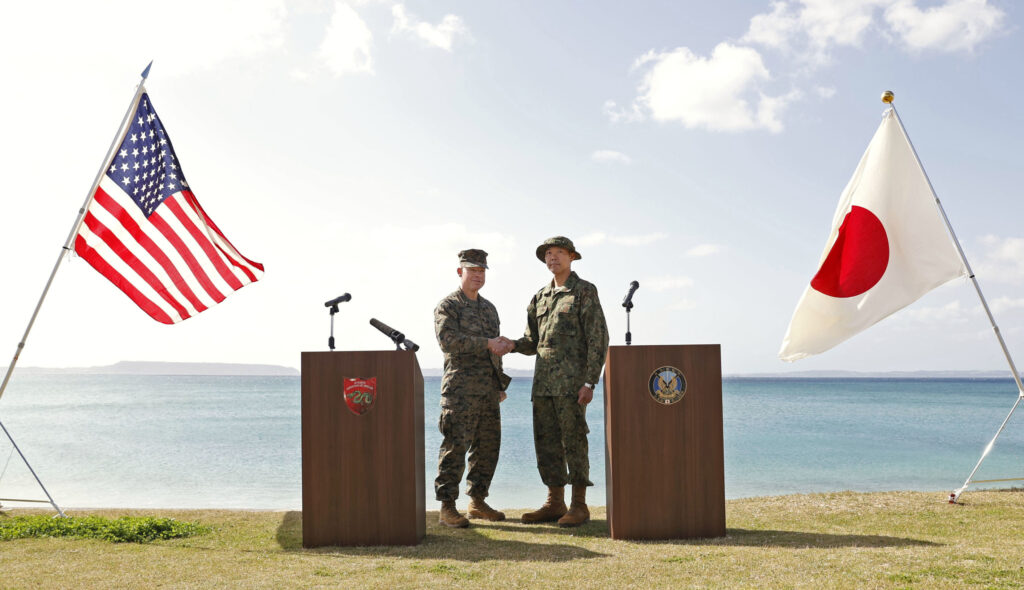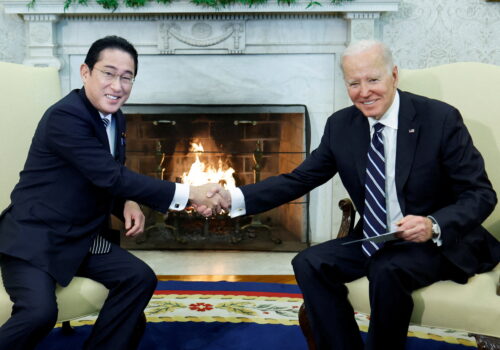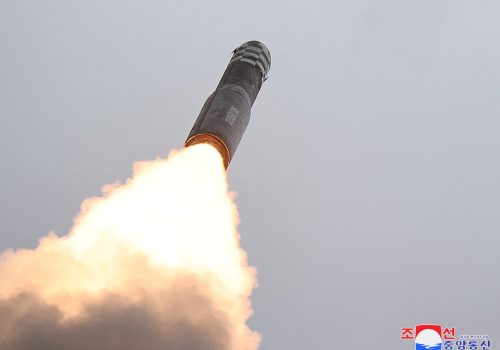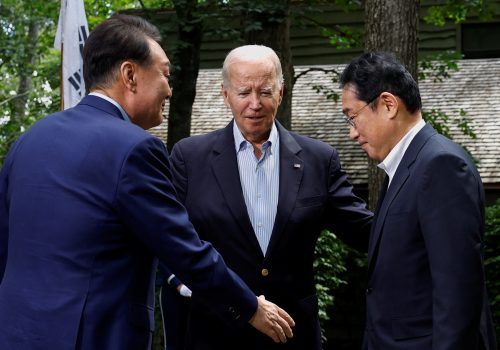At today’s summit between Japanese Prime Minister Fumio Kishida and US President Joe Biden, a wide range of measures will be announced to “upgrade” the US-Japan alliance. Perhaps one of the most vital and least widely understood of these upgrades is the plan to modernize the alliance’s military command and control (C2) arrangements. Today’s announcement will only mark a first step toward what should be larger C2 improvements in the months and years ahead that would be key to ensuring the ability to manage military crises, reinforce deterrence, and defeat aggression if deterrence fails.
This issue is both timely and strategically critical. Our research and analysis at the Atlantic Council’s Indo-Pacific Security Initiative, including private tabletop exercises exploring conflict scenarios, suggests that improved US and multinational C2 arrangements in the Indo-Pacific are urgently needed. This should include a focus on ensuring these C2 structures address three key challenges: conflicts short of full-scale war; simultaneous conflicts with multiple adversaries—particularly China and North Korea; and multilateral rather than just bilateral operations.
In need of an update
Speculation abounds about what form US-Japan C2 modernization will eventually take, and there is no shortage of opinions on what would be best.
Japan itself has already begun the process of modernizing its own C2 arrangements, which had previously not been designed to enable joint operations across Japan’s military services during crises and war. Under Japan’s Defense Buildup Program, announced in late 2022, it has moved to establish a permanent joint headquarters. By 2025, this is planned to take the form of a Japan Joint Operations Command (J-JOC) commanded by a four-star officer with a staff of more than two hundred.
However, most of the recent public discussion, speculation, and debate has focused on what will change with the US command structure in Japan. There is a broad consensus that this structure is a legacy of the vastly different strategic and operational environment of the 1950s and needs updating. For more than six decades, US forces in Japan have fallen under the modestly sized US Forces Japan (USFJ) headquarters at Yokota Air Force Base commanded by a three-star US Air Force general. USFJ has historically not been considered a true “warfighting” headquarters, as it has limited authorities for joint operations—and it also does not have a role in C2 over any Japanese forces.
Planned upgrades
The Financial Times reported that the “biggest upgrade” to the alliance in sixty years will include a plan to “restructure the US military command in Japan to strengthen operational planning and exercises between the nations.” Some speculate that this change will even involve upgrading USFJ to a four-star command like US Forces Korea, in part to allow the USFJ commander to be of equivalent rank to Japan’s J-JOC commander. Whatever form it ultimately takes, a more “operationalized” headquarters in Japan will benefit not only the US-Japan alliance, but also US military capabilities and posture in the western Indo-Pacific.
Though such Japanese and US operational headquarters will improve the ability to employ Japanese and US forces, the new structures must also ensure that US and Japanese forces can more effectively work together to deter aggression and fight alongside each other if necessary. Whether or not their commanders are ultimately four-star level officers, it is still unclear how these two headquarters will work together and what overarching structure will connect them. What is clear is that the US headquarters in Japan will not have authority over the J-JOC. James Schoff, a scholar with the Sasakawa Peace Foundation USA and former Pentagon official, notes that though measures should be taken for “bilateral planning and coordination,” it is “legally and politically impossible” for Japan’s Self Defense Forces to come under US command.
One model for closer integration would be a bilateral command with US and Japanese officers working side by side. The US-South Korea alliance has long had a well-established structure for wartime C2 under a single Combined Forces Command headquarters staffed with US and South Korean military officers commanded by a US four-star general, which conducts bilateral military planning and regular major bilateral exercises. This command is going through a transition itself, under plans to prepare for a South Korean officer to take command of alliance forces in wartime. Though some elements might be taken from this model, it has its own limitations and may not be realistic for the US-Japan alliance.
Schoff—along with Chris Johnstone, another former Pentagon official with deep expertise on Japanese defense issues—recently assessed that parallel structures with separate US and Japanese chains of command will be legally and politically necessary, and argued in favor of a co-located joint, bilateral planning and coordination office to connect these structures. Though this may be pragmatic, it is hardly optimal from an operational perspective. US military doctrine for multinational operations notes that “because of the absence of a single commander, the use of a parallel command structure should be avoided, if at all possible.”
Conditions for success
Whatever form these new C2 arrangements ultimately take, they will have to address the Japanese C2 component, the future structure of US Forces Japan, how US and Japanese forces will operate together in and around Japan, and how these forces will operate with other countries’ forces and farther afield from Japan. Such arrangements should meet several key criteria:
- Enable effective joint and bilateral operations in conflicts short of full-scale war. One of the major shortcomings of the South Korea-US bilateral military structure, according to our analysis, is that it is not designed to respond to a limited attack and it does not enable “quick, calibrated, and combined” bilateral responses to provocations. In case of a small-scale provocation, South Korea’s military commands the response unilaterally, while the US-South Korea Combined Forces Command only takes command for full-scale wartime operations. This leaves a gap in alliance response capability that could be exploited by North Korea. The future US-Japan structure should instead provide political leaders with C2 options for US and Japanese forces to quickly respond together to threats of all types from the very outset of a crisis.
- Prepare to simultaneously confront aggression from China, North Korea, and even Russia. Japan is in the unenviable position of being close to three nuclear-armed adversaries with aggressive authoritarian leaders. In the event of a conflict started by either China or North Korea, Japan is likely to come under attack from either aggressor, even if not initially targeted as the conflict begins. There are also plausible scenarios for simultaneous conflicts with both China and North Korea involving Japan, particularly where a conflict that starts with North Korean aggression leads to China’s involvement, or vice versa. Russia is also a potential threat that could either initiate or be drawn into a conflict—as it has not relinquished its territorial claims in the disputed Northern Territories and is even deploying new weapons there. Whatever US-Japan C2 arrangements are settled upon, they should be designed to confront two or three of these adversaries simultaneously.
- Facilitate multinational rather than just bilateral military operations. The US-Japan alliance may face multiple adversaries, but it also has friends that bring important military capabilities and basing options that can help deter or defeat aggression. So, though getting the bilateral C2 arrangement between the United States and Japan right is important, it will also be important to ensure the new structure effectively enables military operations working with the forces of other allies and partners, particularly Australia, South Korea, Taiwan, and the Philippines.
With the rising risk of Chinese aggression against Taiwan, the crumbling of deterrence on the Korean Peninsula, and Russia more closely aligned with China and North Korea than at any time since the 1950s, it is vital to follow up on the progress announced at today’s summit to ensure that the United States’ C2 arrangements with allies in the Indo-Pacific are best aligned for this new threat environment.
Markus Garlauskas is the director of the Indo-Pacific Security Initiative at the Scowcroft Center for Strategy and Security. He is a former senior US government official with two decades of experience as an intelligence officer and strategist, with twelve years stationed overseas in the region, including five years as the chief strategist for the US-South Korea Combined Forces Command. He posts as @Mister_G_2 on X.
This analysis is informed by Atlantic Council research and tabletop exercises supported by the US Defense Threat Reduction Agency, but it represents the author’s views and not those of any US government organization.
Further reading
Fri, Apr 5, 2024
The US and Japan are upgrading their security alliance. Here’s what needs to come next.
New Atlanticist By Ryo Hinata-Yamaguchi
The upgrades to the US-Japan Security Treaty are welcome, but their effectiveness will depend on how they are implemented in the coming years.
Wed, Aug 16, 2023
The United States and its allies must be ready to deter a two-front war and nuclear attacks in East Asia
Report By Markus Garlauskas
This report highlights two emerging and interrelated deterrence challenges in East Asia with grave risks to US national security: 1) Horizontal escalation of a conflict with China or North Korea into simultaneous conflict; 2) Vertical escalation to a limited nuclear attack by either or both adversaries to avoid conceding.
Fri, Aug 18, 2023
Experts react: The US-Japan-South Korea summit was ‘historic.’ But what did it accomplish?
New Atlanticist By
President Joe Biden, Prime Minister Fumio Kishida, and President Yoon Suk Yeol set forward a common security agenda at Camp David. Atlantic Council experts share their insights on what's next.
Image: Commanding General Hajime Kitajima (R) of the Japan Ground Self-Defense Force's Amphibious Rapid Deployment Brigade and Commanding General Trevor Hall of the 3d Marine Expeditionary Brigade shake hands during a press conference in Kin, Okinawa Prefecture, on March 12, 2024, as their units carry out a joint drill in the southwestern Japan island prefecture. (Kyodo)



